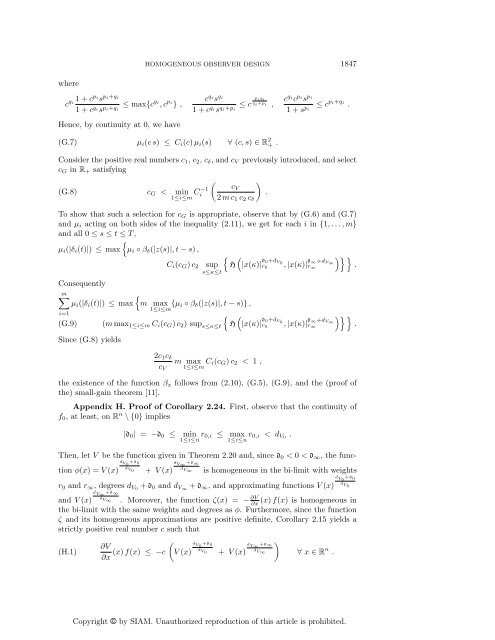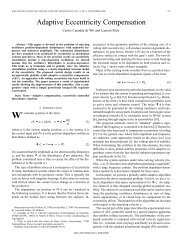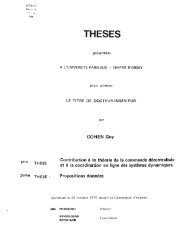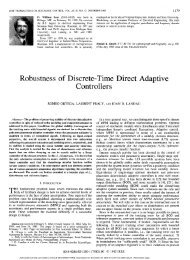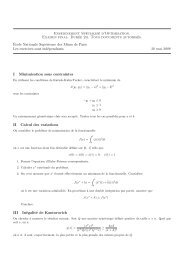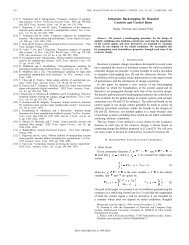Copyright © by SIAM. Unauthorized reproduction of this article is ...
Copyright © by SIAM. Unauthorized reproduction of this article is ...
Copyright © by SIAM. Unauthorized reproduction of this article is ...
You also want an ePaper? Increase the reach of your titles
YUMPU automatically turns print PDFs into web optimized ePapers that Google loves.
HOMOGENEOUS OBSERVER DESIGN 1847wherec qi 1+cpi s pi+qi1+c qi s pi+qi ≤ max{cqi ,c pi } ,Hence, <strong>by</strong> continuity at 0, we havec qi s qi1+c qi s qi+pi ≤ c p i q iq i +p i ,c qi c pi s pi1+s pi ≤ c pi+qi .(G.7) µ i (cs) ≤ C i (c) µ i (s) ∀ (c, s) ∈ R 2 + .Consider the positive real numbers c 1 , c 2 , c δ , and c V previously introduced, and selectc G in R + sat<strong>is</strong>fying( )c V(G.8) c G < min1≤i≤m C−1 i.2 mc 1 c 2 c δTo show that such a selection for c G <strong>is</strong> appropriate, observe that <strong>by</strong> (G.6) and (G.7)and µ i acting on both sides <strong>of</strong> the inequality (2.11), we get for each i in {1,...,m}and all 0 ≤ s ≤ t ≤ T ,µ i (|δ i (t)|) ≤ max{µ i ◦ β δ (|z(s)|,t− s) ,C i (c G ) c 2{ (sup Hs≤κ≤tConsequentlym∑{µ i (|δ i (t)|) ≤ max m max {µ i ◦ β δ (|z(s)|,t− s)} ,1≤i≤mi=1{ ((G.9) (m max 1≤i≤m C i (c G ) c 2 ) sup s≤κ≤t HSince (G.8) yields2c 1 c δc V|x(κ)| d0+d V 0r 0|x(κ)| d0+d V 0r 0m max1≤i≤m C i(c G ) c 2 < 1 ,)} }, |x(κ)| d∞+d V∞r ∞.)} }, |x(κ)| d∞+d V∞r ∞.the ex<strong>is</strong>tence <strong>of</strong> the function β x follows from (2.10), (G.5), (G.9), and the (pro<strong>of</strong> <strong>of</strong>the) small-gain theorem [11].Appendix H. Pro<strong>of</strong> <strong>of</strong> Corollary 2.24. First, observe that the continuity <strong>of</strong>f 0 , at least, on R n \{0} implies|d 0 | = −d 0 ≤ min1≤i≤n r 0,i ≤ max1≤i≤n r 0,i < d V0 .Then, let V be the function given in Theorem 2.20 and, since d 0 < 0 < d ∞ , the functionφ(x) =V (x)d V0 +d 0d V0+ V (x)d V∞ +d∞d V∞<strong>is</strong> homogeneous in the bi-limit with weightsr 0 and r ∞ , degrees d V0 + d 0 and d V∞ + d ∞ , and approximating functions V (x)d V∞ +d∞d V∞d V0 +d 0d V0and V (x) . Moreover, the function ζ(x) = − ∂V∂x(x) f(x) <strong>is</strong> homogeneous inthe bi-limit with the same weights and degrees as φ. Furthermore, since the functionζ and its homogeneous approximations are positive definite, Corollary 2.15 yields astrictly positive real number c such that(H.1)(d∂VV0 +d 0∂x (x) f(x) ≤ −c dV (x) V0d V∞)+d∞d+ V (x) V∞∀ x ∈ R n .<strong>Copyright</strong> © <strong>by</strong> <strong>SIAM</strong>. <strong>Unauthorized</strong> <strong>reproduction</strong> <strong>of</strong> <strong>th<strong>is</strong></strong> <strong>article</strong> <strong>is</strong> prohibited.


